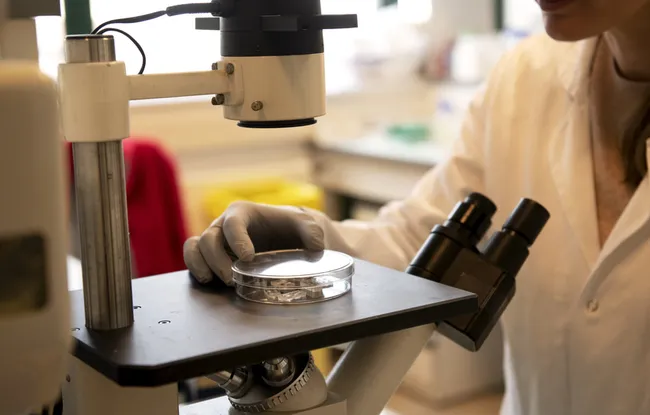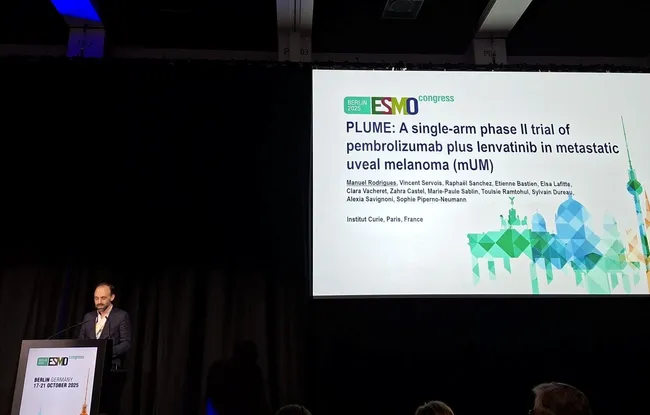- Home >
- Institut Curie News >
- Meiosis and DNA repair: researchers decipher the activity of a specific molecular complex
They have explained the role of the Mlh1-Mlh3 complex in DNA mismatch repair and, quite uniquely, in one of the key steps of genetic mixing during meiosis whose dysfunctions can explain different types of pathologies. Their study has been published in PNAS.
During meiosis, recombination of genetic material between homologous chromosomes occurs, which contributes to genetic mixing. Recombination can only take place through fine mechanisms of breakage and subsequent repair of DNA molecules. These mechanisms are highly conserved in eukaryotes, from yeast to humans. In particular, cross-shaped structures (Holliday junctions) are formed between homologous chromosomes to make crossovers during recombination. These recombination mechanisms are essential to ensure correct segregation of chromosomes in gametes. Failure of these steps results in the generation of gametes with an abnormal number of chromosomes (trisomy, Turner syndrome, infertility).
Two molecular complexes similar and yet... different!
The “Mlh1-Mlh3” complex is a repair factor for DNA mismatches that are generated as a result of errors in replicative polymerases. Mlh1-Mlh3 has endonuclease activity, i.e. it can cut a DNA molecule between two successive nucleotides and not at its ends. Unlike other similar mismatch repair factors, Mlh1-Mlh3 also exerts its endonuclease activity during meiosis, at the Holliday junctions; it is essential for the exchange of chromosome portions. The Mlh1-Pms1 complex, which is the main factor for repairing DNA mismatches, is not involved in meiosis. However, the two complexes have many structural similarities. For example, they are formed by the interaction between the C-terminal domains of Mlh1 and of its partner Mlh3 or Pms1. What are the structural bases for the differences in specificity between Mlh1-Mlh3 and Mlh1-Pms1? Researchers from CEA-Joliot (I2BC department, Structural Biology Laboratory) and Valérie Borde’s team, “Chromosome dynamics and recombination” (CNRS, Sorbonne Université) at Institute Curie, with the help of CEA-Jacob (IRCM department) and a Swiss team, have solved the three-dimensional structure of a complex formed by the interaction domains of Mlh1 and Mlh3 (from purified recombinant proteins) of the yeast S. cerevisiae by radiocrystallography, and have functionally characterized it. They compared it with the already known equivalent complex formed between Mlh1 and Pms1.
Their study, published in PNAS, reveals differences between the two complexes, including protein folding, surface interaction with DNA, formation of filamentary structures and other DNA recognition specificities.
This first comparison at the structural level of the Mlh1-Mlh3 and Mlh1-Pms1 complexes strongly suggests an evolutionary specialization of each. This work opens perspectives to better understand certain pathologies linked to mutations in these complexes affecting repair of replicative errors and meiotic recombination. To go further, it will be necessary to obtain cryo-electron microscopy structures of the two whole proteins, in interaction with their DNA substrate.
These results are the culmination of a fruitful collaboration that began several years ago with the CEA and our Swiss colleagues. We are delighted to have been able to elucidate the intriguing function of this molecular complex involved in DNA repair during meiosis, when a wave of chromosomal recombination occurs. This is another building block for understanding mechanisms at the origin of pathologies such as certain forms of hereditary cancers.
Said Valérie Borde, CNRS researcher and team leader at the Institut Curie

|
Référence : J. Dai, A. Sanchez, C. Adam, L. Ranjha, G. Reginato, P. Chervy, C. Tellier-Lebegue, J. Andreani, R. Guérois, V. Ropars, M-H Le Du, L. Maloisel, E. Martini, P. Legrand, A. Thureau, P. Cejka, V. Borde, J-B Charbonnier. Molecular basis of the dual role of the Mlh1-Mlh3 endonuclease in MMR and crossover formation in meiosis | PNAS, 2021 June 8 118(23) doi: 10.1073/pnas.2022704118 |



